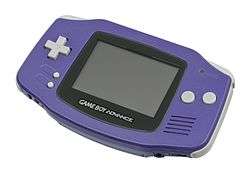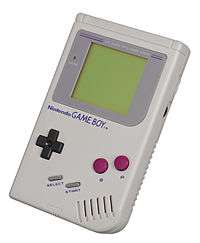Game Boy Advance family
|
The Game Boy Advance logo. | |
| Developer | Nintendo |
|---|---|
| Type | Handheld game console |
| Generation | Sixth generation |
| Retail availability | 2001–2008 |
| Media | Game Boy Advance Game Pak |
| Predecessor | Game Boy line |
| Successor | Nintendo DS line |
The Game Boy Advance family is a series of models of battery-powered handheld game consoles sold by Nintendo. As of June 30, 2010, the Game Boy Advance series has sold 81.51 million units worldwide.[1] It was preceded by the Game Boy line.
The Game Boy Advance family was succeeded by the Nintendo DS line. It (including Game Boy Advance for Ambassadors) has made a return via the Nintendo 3DS Virtual Console and Wii U.
History
| 2001– | – Game Boy Advance | |
| 2002– | ||
| 2003– | – Game Boy Advance SP | |
| 2004– | ||
| 2005– | – Game Boy Micro |
Game Boy Advance

In Japan, on March 21, 2001, Nintendo released a significant upgrade to the Game Boy line. The Game Boy Advance (also referred to as GBA) featured a 32 bit 16.8 MHz ARM. It included a Z80 processor and a switch activated by inserting a Game Boy or Game Boy Color game into the slot for backward compatibility, and had a larger, higher resolution screen. Controls were slightly modified with the addition of "L" and "R" shoulder buttons. The system was technically likened to the SNES and showed its power with successful ports of SNES titles such as Super Mario World, Super Mario World 2: Yoshi's Island, and The Legend of Zelda: A Link To The Past. There were also new titles that you will only find on GBA, such as Mario Kart: Super Circuit and F-Zero: Maximum Velocity, and more. A widely-criticized drawback of the Game Boy Advance is that the screen is not backlit, making viewing difficult in some conditions. The Game Paks for the GBA are roughly half the length of original Game Boy cartridges, and so older Game Paks would stick out of the top of the unit. When playing older games, the GBA provides the option to play the game at the standard equal square resolution of the original screen or the option to stretch it over the wider GBA screen.
Game Boy Advance SP

First released in Japan February 14, 2003, the Game Boy Advance SP—Nintendo model AGS-001—resolved several problems with the original Game Boy Advance model. It featured a new smaller clamshell design with a flip-up screen, a switchable internal frontlight, a rechargeable battery, and the only problem is the omission of the headphone jack, which requires a special adapter, purchased separately. In some regions owners of the original Game Boy Advance received a special limited offer to trade their old models into Nintendo and merely pay the difference on the Game Boy Advance SP. In mid September 2005, Nintendo released a significantly improved Game Boy Advance SP model known as Nintendo model number AGS-101, that featured a high quality backlit screen instead of a frontlit, similar to the Game Boy Micro screen but larger.
Game Boy Micro

The third form of Game Boy Advance system, the Game Boy Micro is four and a half inches wide (10 cm), two inches tall (5 cm), and weighs 2.8 ounces (80g). By far the smallest Game Boy created, it has approximately the same dimensions as an original NES controller pad. Its screen is approximately 2/3 the size of the SP and GBA screens while maintaining the same resolution (240×160 pixels) but now has a higher quality (than the original SP, not the improved SP) backlit display with adjustable brightness. Included with the system are two additional faceplates which can be swapped to give the system a new look; Nintendo of America used to sell additional faceplates on its online store. In Europe, the Game Boy Micro comes with a single faceplate. In Japan, a special Mother 3 limited edition Game Boy Micro was released with the game in the Mother 3 Deluxe Box. The Game Boy Micro is unable to play any original Game Boy or Game Boy Color games, only playing Game Boy Advance titles (with the exception of the Nintendo e-Reader, discontinued in America, but still available in Japan).
Comparison
| Name | Game Boy Micro | Game Boy Advance SP | Game Boy Advance |
|---|---|---|---|
| Logo | |
|
|
| Console |  |
 |
 |
| In production | Discontinued | ||
| Release date |
‹See Tfd› ‹See Tfd› ‹See Tfd›
‹See Tfd› |
‹See Tfd› ‹See Tfd› ‹See Tfd›
|
‹See Tfd›
‹See Tfd›
‹See Tfd›
|
| Launch price | ¥12,000[2] |
¥12,500[3] US$99[3] |
¥9,800 US$149.99 |
| Units shipped | Worldwide: 81.51 million (as of December 31, 2013). | ||
| Best-selling game |
Pokémon Ruby and Sapphire, 13 million combined (as of November 25, 2004)[6] | ||
| Display | 2 in (51 mm) | 2.9 in (74 mm) | |
| 240 × 160 px[7][8] | |||
| 511 simultaneous colors in character mode 32,768 simultaneous colors in bitmap mode[7] | |||
| Backlight - 5 brightness levels | Frontlight On/Off toggle (AGS-001) Backlight Bright/Normal toggle (AGS-101) |
No backlight | |
| Audio | 6 channels (two 8-bit "Direct Sound" PCM channels, plus the 4 channels from Game Boy) | ||
| Single mono speaker[9][10] | |||
| Stereo headphone jack (standard)[10] |
Stereo headphone jack (for headphones specifically designed for the GBA SP) |
Stereo headphone jack (standard)[11] | |
| Processor | 16.8 MHz 32-bit ARM7TDMI |
16.8 MHz 32-bit ARM7TDMI 4 or 8 MHz 8-bit Z80 coprocessor for Game Boy and Game Boy Color emulation, and as a tone generator in Game Boy Advance games | |
| Memory | 256 kB WRAM (outside the CPU) 32 kB + 96 kB VRAM (internal to the CPU) | ||
| Physical media | Game Boy Advance Game Cartridge (2-32 MB) | Game Boy Advance Game Cartridge (2-32 MB) | |
| Input controls |
| ||
| Batteries | 460 mAh lithium-ion battery
|
700 mAh lithium-ion battery[12] | 2 AA batteries
(dependent on the Game Pak being played and volume setting)[13] |
| Connectivity | Fourth generation link port | Third generation link port | |
| Weight | 80 grams (2.8 oz) | 142 grams (5.0 oz) | 140 grams (4.9 oz) |
| Dimensions |
101 mm (4.0 in) W |
84 mm (3.3 in) W |
144 mm (5.7 in) W |
| Colors and styles | List of Game Boy colors and styles | ||
| Regional lockout | No | ||
| List of games | List of Game Boy Advance games | ||
| Backward compatibility | N/A[14] | Game Boy Game Boy Color[7] | |
| Game Boy Advance line size comparison | ||
|---|---|---|
|
Game Paks
Game Boy Advance cartridges used a physical lock-out feature. Notches were located at the base of the cartridge's two back corners. One of these notches was placed as to avoid pressing a switch inside the cartridge slot. When an older Game Boy or Game Boy Color game was inserted into the cartridge slot, the switch would be pressed down and the Game Boy Advance would start in Game Boy Color mode, while a Game Boy Advance cartridge would not touch the switch and the system would start in Game Boy Advance mode. The Nintendo DS replaced the switch with a solid piece of plastic that would allow Game Boy Advance cartridges to be inserted into Slot 2, but would prevent an older Game Boy cartridge from being inserted fully into the slot.
Advance cartridges (Also known as class D) are half the size of all earlier cartridges and are compatible with Game Boy Advance and later systems including the Nintendo DS. Some cartridges are colored to resemble the game (usually for the Pokémon series; Pokémon Emerald, for example, being a clear emerald green). They are also compatible with Nintendo DS and DS Lite (but see the Reception section for limitations). Some Advance cartridges have built-in features, including rumble features (Drill Dozer), tilt sensors (WarioWare: Twisted!, Yoshi's Universal Gravitation) and solar sensors (Boktai). The product ID of games on advance cartridges starts with "AGB".
Accessories
The Game Boy Advance, as with many other consoles, has had a number of releases from both first-party and unlicensed third-party accessories.
Game Boy Player
The Game Boy Player is a device released in 2003 by Nintendo for the GameCube which enables Game Boy (although Super Game Boy enhancements are ignored), Game Boy Color, or Game Boy Advance cartridges to be played on a television. It connects via the high speed parallel port at the bottom of the GameCube and requires use of a boot disc to access the hardware. Unlike devices such as Datel's Advance Game Port, the Game Boy Player does not use software emulation, but instead uses physical hardware nearly identical to that of a Game Boy Advance.
Legacy
The Nintendo DS and Nintendo DS Lite are able to play the large library of Game Boy Advance games (though the Nintendo DSi, Nintendo DSi XL, Nintendo 3DS, and Nintendo 2DS lack a GBA game cartridge slot). However, the DS consoles do not have a GBA game link connector, and so cannot play multiplayer GBA games (except for the few that are multiplayer on a single GBA) or link to the GameCube.
Certain games released for the various Game Boy Advance are available via the Virtual Console service on the Nintendo 3DS. Ten Game Boy Advance games were released to Nintendo 3DS ambassadors, as in Nintendo 3DS owners who logged into the 3DS eShop before the major August 2011 price drop. The Virtual Console GBA features of releases are limited, and there are no plans to release them to the public. However, starting from April 2014, Nintendo has been releasing Game Boy Advance games as Virtual Console titles via the Nintendo eShop for the Wii U.
See also
| Wikimedia Commons has media related to Game Boy and variants. |
References
- ↑ "Consolidated Sales Transition by Region" (PDF). Nintendo. 2010-07-28. Retrieved 2014-07-19.
- 1 2 3 4 5 "Game Boy Micro gets Japanese, European release dates". GameSpot. 2005-08-18. Retrieved 2013-01-26.
- 1 2 3 4 5 "Game Boy Advance SP". IGN. Retrieved 22 January 2013.
- 1 2 "Nintendo Game Boy Advance SP review". CNET. Retrieved 22 January 2013.
- ↑ "Game Boy Micro US Packaging". IGN. September 12, 2005. Retrieved January 26, 2013
- ↑ "Consolidated Financial Statements" (PDF). Nintendo. 2004-11-25. p. 4. Retrieved 2007-11-11.
- 1 2 3 "GBA Technical Specifications". Nintendo. Archived from the original on 2007-10-14. Retrieved 2013-01-26.
- 1 2 "Nintendo Game Boy Micro specs (Black)". CNET. Retrieved 2013-01-26.
- ↑ "Nintendo GameBoy Console Information - Console Database". ConsoleDatabase.com. Retrieved 2013-01-31.
- 1 2 "Nintendo GameBoy Color Advance Console Information - Console Database". ConsoleDatabase.com. Retrieved 2013-02-01.
- ↑ "Nintendo GameBoy Color Console Information - Console Database". ConsoleDatabase.com. Retrieved 2011-02-19.
- ↑ "Nintendo Game Boy Advance SP specs (Platinum)". CNET. Retrieved 2013-01-26.
- ↑ "Game Boy Advance Frequently Asked Questions". Nintendo. Retrieved 2013-01-26.
- ↑ Game Boy Micro Instruction Manual, Page 10". Nintendo. Retrieved on 08-20-09.


